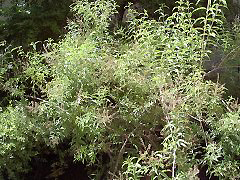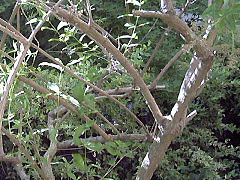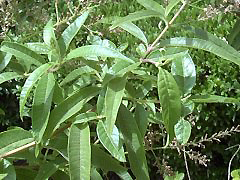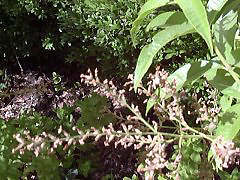Lemon Verbena
Aloysia triphyllaVerbenaceae:
Podcast Script
| Whole Shrub |
Woody Stem |
| Leaves |
Flower |
Classification:
Angiosperm, Dicot, evergreen (but will lose leaves if it is cold enough in the winter in Davis)Size:
Lemon Verbena is a rapidly growing shrub that can reach a height of 15 feet in tropical climates, but which will reach a height of 4 to 5 feet in most other climates.Identifying Features:
Smell and believe. Lemon Verbena has thin leaves about a couple inches long and about half an inch wide, which give off a distinctly lemon-like scent. Lemon Verbena's strong aroma is found to be relaxing and soothing, and also repels insects. The oil extracted from the leaves is used in perfumery and can also serve as an insecticide in 1 to 2 % concentration.Location/Habitat:
Native to South America (Argentina, Chile and Peru); grows in California, N. Carolina, Georgia, and Puerto Rico in the U.S., and in France, and North Africa.Lemon Verbena grows well in warm, moist climates, although it is hardy even in cooler climates, despite being frost sensitive. In more tropical environments, it is a perennial, while in colder climates, it becomes deciduous. In climates that are colder still, it dies back to the ground in the winter, and grows again in the spring.
Flower/Fruit/Reproduction:
Lemon Verbena is commonly propagated using softwood cuttings. While the Lemon Verbena does have flowers, it is disputed if the plant will grow true from seed.Water/Sun Requirements:
Lemon Verbena likes a moist environment with lots of sun. (It grows up to 15 feet tall in the tropics.)Special Adaptations:
Lemon Verbena gives off an odor reminiscent of lemons, which helps repel bugs. Although this adaptation has probably been bread by people, it most likely evolved initially to protect itself from being consumed.Other Info:
Lemon Verbena contains the active compounds cineole, tannins, mucilage, flavonoids, limonene, geraniole, and citral. Lemon Verbena is found to be relaxing and helpful to digestion, and is commonly used in teas, flavorings, fragrances, antispasmodics, carminatives, sedatives, and stomachics.Lemon Verbena serves many culinary purposes, it is can be used to make lemon flavored liquors, syrups, butters, scones, and sorbet. A few example recipes for Lemon Verbena Custard can be found here.
Reference Sources/Links:
"Aloysia Triphylla." Mountain Valley Growers. 31 May 2007 http://www.mountainvalleygrowers.com/alotriphylla.htm ."Aloysia Triphylla." Plants For A Future. 31 May 2007 http://www.pfaf.org/database/plants.php?Aloysia+triphylla .
"Aloysia Triphylla." Plants Profile. 31 May 2007. USDA. 31 May 2007 http://plants.usda.gov/java/profile?symbol=ALTR6 .
"Creating an Herb Garden." National Gardening Association. 1 June 2007 http://www.kidsgardening.com/growingideas/projects/may04/pg1.html .
Grieve, M. "Verbena, Lemon." Botanical. 31 May 2007 http://botanical.com/botanical/mgmh/v/verlem05.html .
"Herbal Remedies Using Lemon Verbena." 30 May 2007. Ageless Herbal Products. 31 May 2007 http://www.ageless.co.za/lemon_verbena.htm .
"Lemon Verbena." 31 May 2007 http://www.desert-tropicals.com/Plants/Verbenaceae/Aloysia_triphylla.html .
"LEMON VERBENA." 6 Dec. 1997. Purdue. 31 May 2007 http://www.hort.purdue.edu/newcrop/med-aro/factsheets/LEMON_VERBENA.html .
"Lemon Verbena." 3 Apr. 2007. 31 May 2007 http://www.drugs.com/npp/lemon-verbena.html .
"Lemon Verbena." Monteray Bay Spice Company. 31 May 2007 http://www.herbco.com/bulk_herbs/Lemon-Verbena.php .
"Lemon Verbena, Verveine Odorante." 31 May 2007 http://davesgarden.com/pf/go/279/ .
Written by E. Slaughter, Spring 2007.



